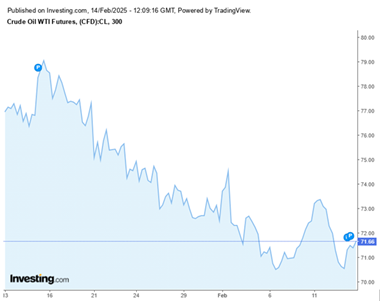The US crude oil market continues to show signs of supply-side pressure, with commercial crude inventories rising by 4.1 million barrels last week, bringing total stockpiles (excluding the Strategic Petroleum Reserve) to 427.9 million barrels. Despite this build-up, inventories remain 4% below the five-year seasonal average, reflecting an ongoing rebalancing process in the market.
At the same time, West Texas Intermediate (WTI) crude oil prices dropped to $71.32 per barrel, marking a $1.52 decrease from the previous week and a $5.94 decline year-over-year. This downward movement suggests that the current supply levels, coupled with broader economic uncertainties, are exerting bearish pressure on crude prices. 
Refinery Utilization and Fuel Production
Refinery utilization in the US stood at 85% of capacity, with crude oil inputs averaging 15.4 million barrels per day (bpd)—a slight increase of 82,000 bpd compared to the previous week. Gasoline production saw a moderate rise, averaging 9.3 million bpd, while distillate fuel production declined to 4.5 million bpd.
Despite an uptick in crude processing, gasoline inventories declined by 3.0 million barrels, leaving them 1% below the five-year seasonal average. Distillate fuel stocks, which include diesel and heating oil, saw only a marginal increase of 100,000 barrels, but they remain 11% below historical levels.
Import and Export Dynamics
Crude oil imports fell significantly by 606,000 bpd week-over-week, averaging 6.3 million bpd. However, over the past four weeks, the average import level stood at 6.6 million bpd, reflecting a 7.6% increase year-over-year. Meanwhile, crude exports remained strong at 4.1 million bpd, highlighting the US’s continued role as a key supplier to global markets.
With total commercial petroleum inventories rising by 1.2 million barrels, the market remains in a delicate balance between domestic supply growth and external demand forces.
Price Outlook: What’s Next for Oil?
The combination of rising inventories, softer demand signals, and macroeconomic headwinds suggests continued downside risks for oil prices in the near term. However, geopolitical factors, OPEC+ decisions, and broader market sentiment could still introduce volatility, leading to potential price swings.
For traders and investors, monitoring weekly EIA reports will be crucial in assessing supply-demand imbalances, refining activity, and US import/export flows, all of which play a key role in shaping short-term oil price movements.
